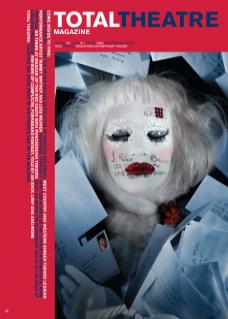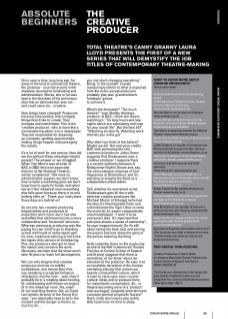Once upon a time, long long ago, far away in the land of commercial theatre, the producer scurried around in the shadows, doomed to fundraising and administration. Worse, she or he was kept in the shackles of the pernicious idea that an administrator was not – and could never be – creative.
How things have changed! Producers have become leaders, who instigate things they’d like to curate. They energise and matchmake. This is the ‘creative producer’, who is more like a commissioning editor is to a newspaper. They are responsible for dreaming up concepts, spotting opportunities, making things happen and packaging the results.
It’s a lot of work for one person. How did we live without these amazingly helpful people? The answer is: we struggled. When Tom Morris was director of BAC in 2002 (he’s now associate director of the National Theatre), artists complained: “We have no administrative support; we don’t know how to write a marketing plan; we don’t know how to apply for funds; and when we’re in the rehearsal room everything else falls apart because there is no one looking after us”. Thank your lucky stars those days are behind us!
So not only has creative producing helped artists and producers to enjoy their work more, but it has also reshuffled that old hierarchy into a more collaborative and ‘horizontal’ structure. Whereas previously, producing was like paying for your child to go to boarding school with loads of name-taped gym kit, now, creative producing is more like the hands-dirty version of childrearing. Plus, the producers also get to have the nookie and conceive the work. Obviously, we hope that the show won’t take 16 years to reach full development.
We can only imagine that creative producers must be incredible multitaskers: one minute they’ll be, say, tweaking a script/performance storyboard, and the next ... well, they’ll probably be in a meeting about funding. Or collaborating with flower-arrangers. Or in the rehearsal room. Yes, even! Or out watching theatre. But, as David Lan (artistic director of the Young Vic) says, “you absolutely have to be in the moment and the danger is there’s so much to do ... you risk short-changing everything”. Being ‘in the moment’ sounds reassuringly similar to what is expected from the actor, except producers probably play less ‘grandmother’s footsteps’ games to achieve it.
What’s the downside? “Too much theatre!” says Shelley Hastings, producer at BAC. I think she means watching it. “It’s long hours and late nights which are exhausting and crap for your social life”. But the best bit? “Watching an idea fly. Watching work that hits you in the gut”.
Why didn’t we think of this before? Maybe we did. Not everyone credits BAC with pioneering the role: commercial producer Julius Green suggests that Shakespeare was a creative producer. I suppose there is a certain similarity between A Midsummer Night’s Dream and, say, the carnivalesque rompings of Lost Vagueness at Glastonbury, and it’s warming to imagine the Bard as a collaborative event-maker.
Still, whether it’s warranted or not, Shakespeare gets all the credit, whereas creative producers like Michael Morris of Artangel (who had the idea for Shockheaded Peter and commissioned the Tiger Lillies to write the score for it) remain comparatively unacknowledged. “I want it to be everyone’s idea. It’s important that everyone shares a sense of ownership”, he says magnanimously. So it’s still about taking the back seat and serving the project and less about the glory of the person motoring the thing.
Andy Lavender (tutor on the producing strand of the MA in Advanced Theatre Practice at Central School of Speech and Drama) suggests that there is something ‘of our times’ about our elevation of the producer. He sees it as an inevitable derivation of the tireless marketing industry that motors our heavily commodified culture, which is keen to seize upon even countercultural ideas and re-produce them for mainstream consumption. So... is theatre becoming more of a ‘product’: well-packaged, zeitgeisty entertainment concepts pitched at specific buyers? Hush, child, don’t worry your pretty little head now, it’s time to sleep.
Want to know more about creative producers? Here’s some leads…
Andy Lavender teaches on the producing strand of MA Advanced Theatre Practice, Central School of Speech and Drama: www.cssd.ac.uk/postgrad.php
Michael Morris can be found at Artangel: www.artangel.org.uk
Louise Jeffreys is head of theatre for the Barbican, and programmes the Bite season: www.barbican.org.uk/theatre
Tom Morris is associate director for National Theatre: www.nationaltheatre.org.uk
David Jubb is artistic director of Battersea Arts Centre www.bac.org.uk
Judith Knight is co-founder of Artsadmin and Manick Govinda is head of artists’ advisory services at Artsadmin: www.artsadmin.co.uk
Helen Cole is producer of live art and dance at Arnolfini, Bristol: www.arnolfini.org.uk
David Lan is artistic director and chief executive of the Young Vic: www.youngvic.org
Helen Marriage and Nicky Webb are cofounders/directors of Artichoke, which brought The Sultan’s Elephant to London: www.artichoke.uk.com
Simon Casson is the creative producer for Duckie: www.duckie.co.uk
Richard Kingdom is performance programme manager at The Bluecoat, Liverpool www.thebluecoat.org.uk
Kate McGrath is a co-founder of Fuel and a producer for the Lyric Theatre, Hammersmith: www.fueltheatre.com
Helen Crocker is creative producer for circus and theatre with Theatre Bristol/CAST: www.theatrebristol.net
Arts Council England and Scottish Arts Council offer bursaries and other schemes to promote creative producing: www.sac.org.uk and www.artscouncil.org
Two useful publications:
Creative Producing: A User’s Guide ed. Anthony Dean/John Daniel. Published by Central School of Speech and Drama. ISBN 0-9537729-34
The Producers: Alchemists of the Impossible Kate Tyndall. Published by Arts Council England & The Jerwood Charitable Foundation. ISBN 978-0-7287-1347-5

